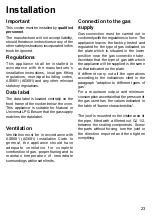
10
Using the Conventional Oven
When using this setting, heat comes from
both the top and bottom elements. This allows
you to cook on a single level and is particularly
suitable for dishes which require extra base
browning such as pizzas, quiches and flans.
Gratins, lasagnes and hotpots which require
extra top browning also cook well in the
conventional oven. This form of cooking gives
you the opportunity to cook without the fan in
operation.
How to Use the
Conventional Oven
1. Turn the oven function control knob to the
required cooking function ( ).
2. Turn the thermostat control to the required
temperature.
Top oven element only
This function is suitable for finishing cooked
dishes, e.g. lasagne, shepherds pie,
cauliflower cheese etc.
Bottom oven element only
This function is particularly useful when blind-
baking pastry. It may also be used to finish off
quiches or flans to ensure the base pastry is
cooked through.
Food
Temperature (°C)
Shelf
Cooking
Positions*
Time (mins)
Biscuits
170-200
6 - 8
25-30
Bread, buns, yeast, doughs
200-230
5
35-45
Casseroles
140-170
3 - 5
90-180
Cakes - small, Queen Victoria sponge
170-190
5 - 7
18-25
Cakes - madeira, rich fruit
130-180
5
90-150
Choux pastry, eclairs
200-230
7
30-35
Fish
200-230
5 - 9
20-40
Fruit pies, plate tarts, crumbles
180-210
6
50-65
Meringues
90-100
6
90-150
Milk puddings
140-160
5
90-150
Pate, terrine (in baine-marie)
160-180
1 - 3
60-90
Pizzas
200-230
3 - 5
25-30
Puff pastry, sausage rolls, vol-au-vents
230-250
6
15-25
Quiches, flans
170-200
4 - 6
50-60
Scones
230-250
7 - 8
8-12
Souffle
200-230
6
35-45
Stuffed vegetables
230-250
6 - 8
35-45
Roast meat & poultry
180-200
6
Yorkshire pudding
200-230
7 - 8
40-50
Keep food warm, heat dishes
90-100
6
Cooking Chart - Conventional oven
* The shelf positions are counted from the bottom of the oven.










































